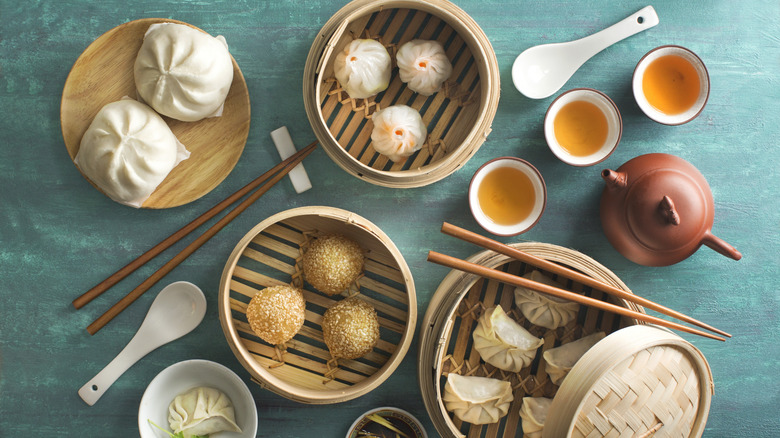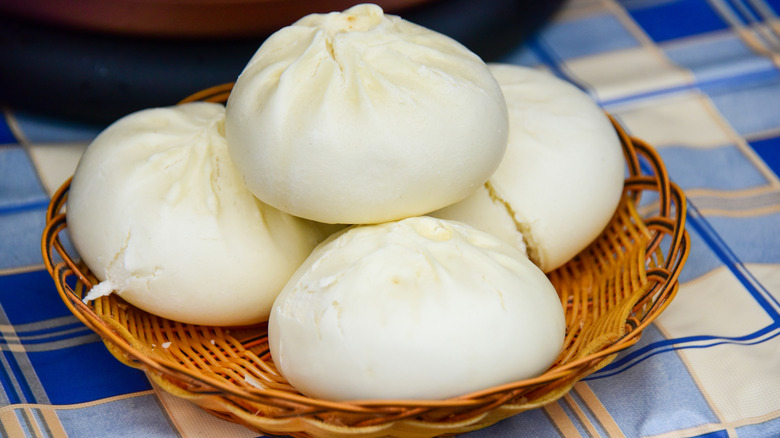Hutong New York's Guide To An Elevated At-Home Dim Sum Brunch
Dim sum is one of the world's great convivial meals. There's a special delight to enjoying a variety of mouthwatering dishes and sharing them among family and friends. Emerging from a tradition of consumption at tea houses, the meal's more frequently eaten out. Visit such an eatery, and you'll find that the typical dim sum menu contains a numbered sheet dozens of items long. Recreating the extensive selection may seem intimidating, but there's merit to bringing the experience into the domestic realm.
Thankfully, Ken Lin offers advice on creating an at-home dim sum brunch. Chef of Hutong New York City, he's certainly experienced at crafting an eye-popping spread with an elevated flair. By offering tips on the dish selection, preparation, presentation, and unique flourishes, this is the guide you need to tackle the experience. Sure, it'll take some effort, but carefully combine the dishes, and you'll dazzle guests with the dim sum magic.
Choose a concise and varied selection of dishes
Before diving into preparation, you'll want to sketch out a menu plan. Since the dim sum possibilities are so wide-ranging, condensing your spread to just a handful of dishes feels intimidating. Chef Lin proposes that it's all about quality over quantity. "We recommend five to six thoughtfully chosen items," he says.
A more focused assortment that combines different flavors and textures will check all of the boxes. "A mix of steamed, fried, and baked items offers variety," notes Chef Lin, so mix up the preparation method to impart natural versatility. Of course, common favorites like soup dumplings or wontons, bao buns, and rice rolls are all welcome to the table. However, you'll also want to think about the ratios of each food category. Chef Lin suggests "a balance of 50% dumplings, 30% buns, and 20% vegetable-forward items." There's still lots of malleability in such a template, but it'll help you achieve a balanced brunch.
Prepare certain foods in advance
As a chef of any food category will know, timing is everything, and you'll want to be especially savvy with the dim sum spread. There's lots of simultaneous cooking to manage, and prepping ahead will lower the stress levels. Even if you do choose to make most items from scratch, many will reheat well. Chef Lin urges to not overthink it with most items and assemble things like dumplings, buns, and bao ahead.
The dish's durability varies by item, but many will keep for ample time. Homemade dumplings will store in the freezer for weeks, while a bao bun can be refrigerated for five days. Don't neglect prepping sides like sauces, too. With the hot dishes, simply "reheat by steaming just before serving to maintain freshness and aroma," Chef Lin says. After a speedy, five- to 10-minute steam, many of your items will be ready to hit the table.
Consider purchasing some items already cooked
There's a special pride to crafting every element from scratch, but it's not essential to assembling a tasty dim sum. Chef Lin advises that carefully sourcing artisanal products can help the meal come together with ease — it's simply a matter of knowing what items to buy. For an easy shopping spree, Chin Lin recommends taking care of the dessert finale by "sourcing Hong Kong–style egg tarts or sesame balls for a sweet finish." Head to your nearest Asian specialty grocer or bakery to discover such treats.
Furthermore, get creative by mixing elements of do-it-yourself and store-bought. Chef Lin advocates for pre-made dumpling wrappers. You can also find frozen bao buns, too, with the filling for both items still in your hands. Even if you do decide to go with a fully store-bought item, you could employ the Trader Joe's recipe hack for frozen chicken soup dumplings to offer your own twist.
Add creative flourishes to dim sum classics
Crafting dim sum in the home also presents an opportunity to include signature enhancements. Just a few ingredients can wonderfully elevate a dim sum snack, making your rendition especially memorable to family and friends. Chef Lin graciously provides a mouthwatering assortment of hassle-free ideas. For instance, he suggests that you can rework congee just by topping it with crispy shallots or a chile-onion drizzle.
Dumplings are an especially great canvas for a decadent touch — you'll only need to modify the filling. Craft a batch of champagne-infused shrimp dumplings by simply adding "a splash of rose or infused champagne" into the seafood mix, says Chef Lin. Or, go further with the crustacean theme by making a batch of rich and succulent lobster dumplings. In the vegetable category, wild mushroom or truffle dumplings will impress: Just use "a touch of truffle oil to add an earthy, umami profile," says Chef Lin. And, don't sleep on siu mai modifications, either. He suggests, "Add a touch of yuzu zest or a hint of foie gras to shrimp or pork siu mai for depth."
Note presentation and pacing
Finally, with all the culinary elements in place, it's time to plan out the serving style. How the food comes out strongly impacts the dining experience — dim sum eateries have a specific pacing in place. So, Chef Lin urges us to think about the coursing in a manner similar to other elaborate meals. He suggests "starting with lighter items like seafood dumplings and progressing to richer buns for a traditional feel." Dim sum isn't meant to be a quick eating experience, but rather a savored affair. So, pauses between dishes are expected — they're time gaps for guests to mingle.
To further enhance the traditional feel, it's a good idea to stock up on steamer baskets. Chef Lin notes that the vessels are an important aspect of presentation, so even just transferring the food to the container establishes authenticity. The enclosed wooden contraption comes with functional use, toio, since "using bamboo steamers at home keeps items warm," he says. When you fill such with vessels with thoughtful, well-prepared foods, you've put together the elements of an at-home dim sum brunch that many won't forget.





